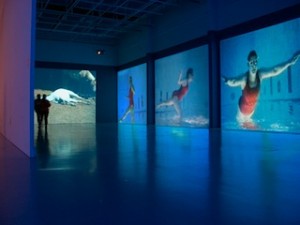 The new journal online ARTis ON by the ARTIS – Institute of History of Art from the School of Arts and Humanities of the University of Lisbon is organizing a new issue dedicated to the question Medium/Post-medium oscillations in contemporary art.
The new journal online ARTis ON by the ARTIS – Institute of History of Art from the School of Arts and Humanities of the University of Lisbon is organizing a new issue dedicated to the question Medium/Post-medium oscillations in contemporary art.
After conceptual art, installation, video, or more recently with the aggregative structure of the contemporary installation, we are broadly facing an intermedia recurrence in the contemporary artistic practices. As David Joselit puts it, in is article On Aggregators, “in each sense an aggregate selects and configures relatively autonomous elements”. Independently of these elements can be characterized as fixed typologies or not, more recent installations confront us with disparate aspects originated in the assembled different media. An intermediality, based on an additive principle, seems to go along with a multimediality, where isolate aspects of different media form particular combinations (J. Müller). Their relations exist through a main cohesive force among all of them, which is the narrative.
Art in general, that seems to overshadow these artistic practices, and coined by Rosalind Krauss as “art in the age of post-medium condition”, is not going without an involvement and a selective demand or twist on particular conventions stressed in such elements of the whole. This intermediate position is not only the exploiting task of a recursive structure out of a formal mediation on the medium, presupposing a specificity in the sense Donald Judd gave to his specific objects. It is basically a process of dissemination that brings aspects derived from a physical or technical level of the media along with others coming from the inquiring of associated layers with cultural habits and its conflicts conveyed by the images, objects or documents aggregated in the installation. So what was not a medium consecrated by art history becomes it, which means paradoxically the readymade turned to be a medium candidate. From the physical constituencies of the medium to a reconsideration of image and object uses in the framework of a given culture, all these aspects form “the conventions of a given art whose definition is throughout historical” (Thierry de Duve).
The fact that a medium is not only an a priori given set of conventions but a performance of all these aspects unfolds it in a becoming. This process enables to think the artistic practices as something not inert or self-contained but constructions implying a self-deferral, time, circulation and reception, all the aspects that make possible the disruptive sense of place, time, perception or culture that these installations work on. As Samuel Weber stated “Western theater has long occupied an uneasy position between ‘art’ and ‘entertainment’, between discovery and manipulation, and this situation has not changed”. How contemporary installation practice positions itself to this tradition? What are the recurrent media assembled and are they still recognizable as such in a video installation? From the materiality to the ideological conventions of the medium, how these installations work to redefine the medium itself or the media aggregate? How narrative and theatricality relate to each medium and how do they relate to each other? Can they be understood as a medium? Is it the exhibition its own medium? What is today’s relevance for art history to stress mediality as a basis for further assumptions? In a world where the production of cultural commodities became a strong economic branch, where the artistic production is part of it, what is the political significance to make visible a communicative process without an end (Agamben) supposed by the exposition of the mediality itself?
This issue of ARTis ON journal aims to examine the questions raised by the contemporary practice of installation to the notion of medium and their subsequent considerations for the concepts of art history. The articles to be submitted may address the above topics or others considered significant for the theme.
We invite art historians, art critics, curators, artists and those interested on the theme to send their papers until June 15, 2016, according the journal standards : ARTis ON – Guide éditorial
Articles are accepted in Portuguese, English, Spanish, French and Italian.
Within the same period, will also be accepted small articles intended for the Varia section, which will have not to be subordinate to the central theme of the magazine.
All items should be sent to revistaartison@letras.ulisboa.pt and pedrolapa@letras.ulisboa.pt
Scientific coordination:
Clara Moura Soares is Assistant Professor in History of Art at School of Arts and Humanities of the University of Lisbon and researcher at ARTIS – Institute of History of Art. She is Associate Director and General Editor of the Journal ARTis ON.
Pedro Lapa is Visiting Assistant Professor in History of Art at School of Arts and Humanities of the University of Lisbon, researcher at ARTIS – Institute of History of Art, and Artistic Director of Museu Coleção Berardo, Lisbon. His most recent publications on this theme are James Coleman, Mediaspectrologies (2005), MNAC –MC, or his new book History and Interregnum. Three works by Stan Douglas (2015), Archive Books.
Secretariat:
Inês Cristóvão (ARTIS – Institute of History of Art, School of Arts and Humanities of the University of Lisbon)

Leave a Reply
You must be logged in to post a comment.